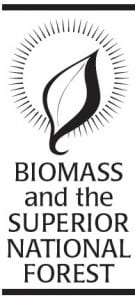The logging industry has all but disappeared in Cook County. Loggers cannot afford to pay the prices set by the US Forest Service and the DNR, even though those prices have fallen, and loggers have difficulty selling their wood. The kind of wood that is more marketable is not the wood being offered in timber sales. At the Cook County Local Energy Project meeting last spring, Paul Nelson pointed out that the paper and building industries were down, major newspapers were going under, and the economy was bad.
The 1978 Boundary Waters Canoe Area Wilderness Act called for increased harvest from Superior National Forest areas outside the wilderness. Regulations that require the Forest Service to prepare environmental assessments and gather public input, followed by lawsuits over timber sales and the appeal process, have added great cost to operation of the Forest Service. Over the last decade, the sale of timber combined with funding for administering those sales did not cover the cost of doing business.
According to Superior National Forest/Gunflint District Ranger Dennis Neitzke, the Forest Service would probably not get paid as much for biomass harvest as it does for timber harvest, but it would be a source of income the Forest Service doesn’t have now. The Forest Service sometimes conducts secondary treatments after logging sales, such as burning branches left behind. Rather than incur the cost of burning it, the Forest Service could sell it as renewable fuel.
Unused Blowdown wood becomes fuel
Some people might wonder why so much of the wood from the 1999 blowdown was never harvested. Instead, it became fuel for fires a decade later such as the 2007 Ham Lake Fire. According to Gunflint District Ranger Neitzke, everything outside the wilderness that could be reached without prohibitive cost was put up for sale. Some wood was offered for sale but didn’t sell; some sold but was never harvested. Prescribed burns were conducted on areas that couldn’t feasibly be logged.
The National Environmental Policy Act of 1969 (NEPA) outlines steps that can be followed to override existing laws regarding wilderness areas. About the same time as the Blowdown, those steps were followed in order to clean up after a natural disaster in a wilderness area in the Black Hills.
The need to develop a biomass fuel-reduction program such as Firewise is important, Neitzke said. Trees that are used for energy in place of fossil fuels are replaced by new trees that take excess carbon out of the air. “It’s all renewable,” he said. Enough biomass is available in the Superior National Forest to provide a significant source of energy for Cook County that is also sustainable.
Neitzke believes the following objectives could be amenable to a wide variety of groups with interest in federal forests: 1) reducing fire hazard; 2) wildlife management; and 3) renewable energy.
Places already using biomass
Since 2003 when St. Paul started using wood chips to help meet its electric and heating needs, its reliance on fossil fuels has been reduced by 70%. Eighty percent of St. Paul’s central business district and adjacent areas, including 185 buildings and 300 houses and even the capitol building, are on this system. The biomass comes from local wood waste. St. Paul’s wood-fired plant is the largest in the nation.
Forty-one Vermont schools are heated with biomass. Schools range between 23,000 and 890,000 square feet and save an average of $61,000 a year in fuel bills. As a comparison, the Cook County Schools complex has 129,800 square feet to heat. In addition to that, it has 4,500 square feet in its bus garage, which uses waste oil to generate about 85% of the heat it needs each winter.
Ninety-nine percent of Gussing, Austria’s 1,500 households, schools, hospital, businesses, and industrial park are powered with biomass. The electricity generated from waste from local farms provides 1½ times the amount of electricity used by this town of 3,811 people. According to Dovetail Partners, the nonprofit organization heading a study on the potential of using biomass to heat publicly and privately owned buildings in Cook County, Gussing now has over 1,000 jobs related to energy.
A considerable number of municipal energy plants in Europe that burn biomass also burn trash, a technology that has some vehement opponents here in America.
The State of Minnesota has declared that by 2025, 25% of the state’s electricity must come from renewable power sources. New federal legislation regarding the amount of carbon release allowed from biomass facilities, however, may make it more difficult to get that power from biomass.
This is the fifth in a series of articles on issues related to utilizing biomass from the Superior National Forest as a source of local renewable energy and its potential to benefit the economy of Cook County.
A grant-funded study is underway to analyze the feasibility of bringing biomass heat and power to Cook County. On April 5, the professionals conducting the study met with a local advisory group. At that meeting, numerous potential benefits of biomass energy were discussed. The list includes:
. Reducing wild fire risk through continued clearing of brush and dead wood;
. Making use of plentiful local source of fuel;
. Reducing smoke and airborne particulates that result from open burning of slash piles;
. Cost savings over fossil fuels and electric heat;
. Reducing carbon footprint by decreasing consumption of fossil fuels;
. Improving the local economy through development of industry and creation of jobs;
. Independence from foreign fuel sources.



Loading Comments